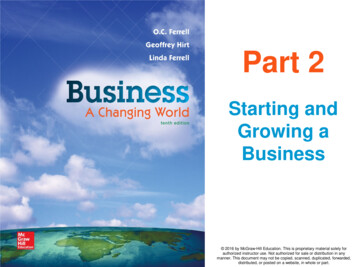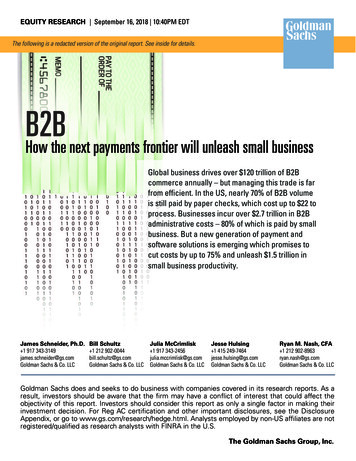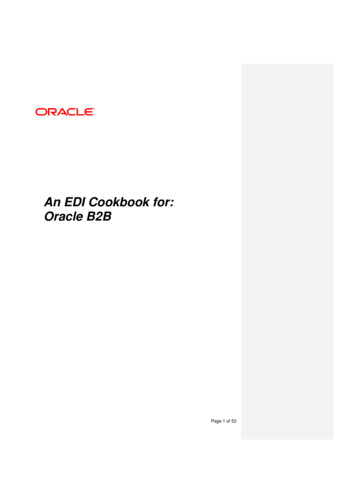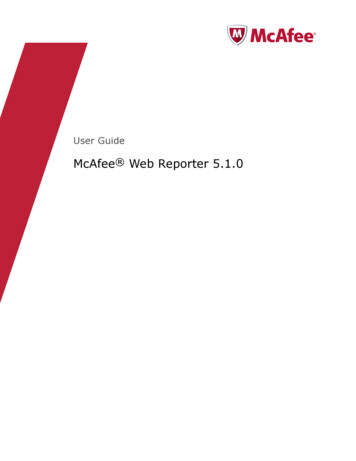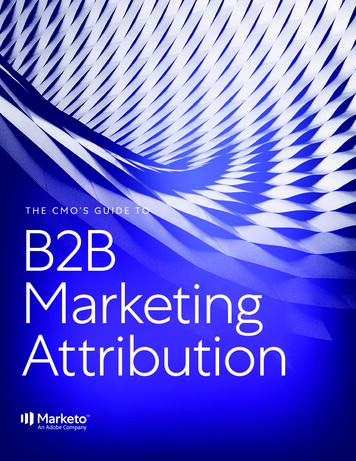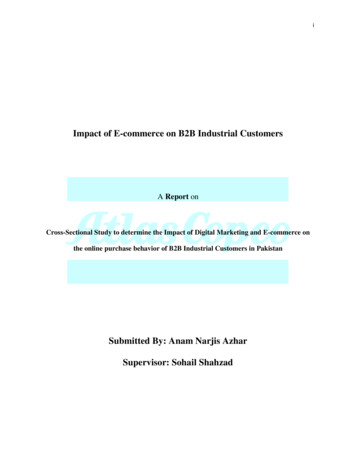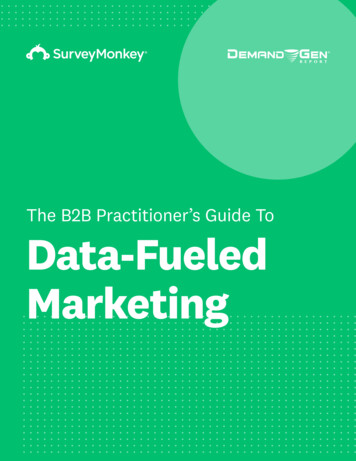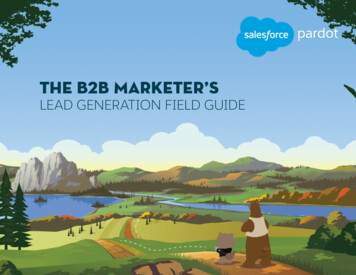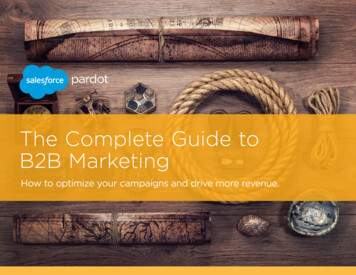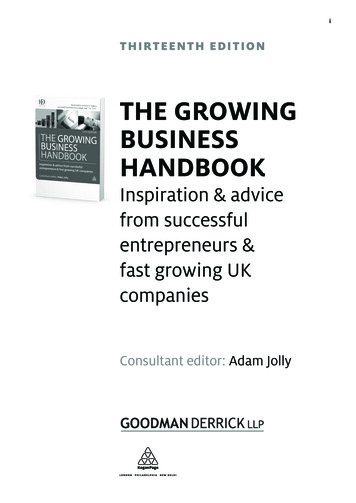
Transcription
iTHIRTEENTH EDITIONTHE GROWINGBUSINESSHANDBOOKInspiration & advicefrom successfulentrepreneurs &fast growing UKcompaniesConsultant editor: Adam Jolly
iiPublisher’s noteEvery possible effort has been made to ensure that the information contained in this book isaccurate at the time of going to press, and the publishers and authors cannot acceptresponsibility for any errors or omissions, however caused. No responsibility for loss or damageoccasioned to any person acting, or refraining from action, as a result of the material in thispublication can be accepted by the editor, the publisher or any of the authors.First published by Kogan Page Limited in 1997 as CBI Growing Business HandbookFourth edition published in 2001 as IOD Growing Business HandbookSeventh edition published in 2004 as The Growing Business HandbookTenth edition 2008Eleventh edition 2009Twelfth edition 2010Thirteenth edition 2011Apart from any fair dealing for the purposes of research or private study, or criticism or review, aspermitted under the Copyright, Designs and Patents Act 1988, this publication may only be reproduced,stored or transmitted, in any form or by any means, with the prior permission in writing of thepublishers, or in the case of reprographic reproduction in accordance with the terms and licencesissued by the CLA. Enquiries concerning reproduction outside these terms should be sent to thepublishers at the undermentioned addresses:120 Pentonville Road1518 Walnut Street, Suite 1100London N1 9JNPhiladelphia PA 19102United KingdomUSAwww.koganpage.com4737/23 Ansari RoadDaryaganjNew Delhi 110002India Kogan Page and individual contributors, 1997, 1999, 2000, 2001, 2002, 2003, 2004, 2006, 2007,2008, 2009, 2010, 2011The right of Kogan Page and individual contributors to be identified as the authors of this work has beenasserted by them in accordance with the Copyright, Designs and Patents Act 1988.ISBN 978 0 7494 6146 1E-ISBN 978 0 7494 6188 1British Library Cataloguing-in-Publication DataA CIP record for this book is available from the British Library.Library of Congress Cataloging-in-Publication DataThe growing business handbook : inspiration and advice from successful entrepreneurs and fastgrowing UK companies / [edited by] Adam Jolly. -- 13th ed.p. cm.ISBN 978-0-7494-6146-1 -- ISBN 978-0-7494-6188-1 1. Success in business. 2. Management. 3.Small business--Growth. 4. Entrepreneurship. I. Jolly, Adam.HF5386.G787 2011658--dc222010048638Typeset by Saxon Graphics Ltd, DerbyProduction managed by JellyfishPrinted and bound in the UK by CPI Antony Rowe
iiiTheperfectpropertyfor yourbusiness Focused on our customers Flexible terms A wide range of properties0800 830 840networkrail.co.uk/property
ivSuffering from. Budget cuts? Travel restrictions? Increased operational costs? Need to differentiate your businessfrom the competition? Not enough hours in the day?Telepresence, the newgeneration videoconferencingwill get you face to face, now,wherever you are.Telepresence is increasingproductivity, building trust andcutting costs.The First ConnectionsTelepresence Managed Servicewill revolutionise your businessand on average pay for itselfwithin 10 months.To find out how this technologycan help your business worksmarter contact us now for afree no obligation trial.sales@firstconnections.co.ukor on 0800 096 6396Connecting people and ideaswww.firstconnections.co.uk
vC ontentsPart One Planning for growth1.11Business models and competitive advantage3Colin Mason, University of Strathclyde and Ross Brown,Scottish EnterpriseBusiness models: a definition 3Case studies of high-growth companies 4Conclusion 71.2How to compete against fast-moving, innovativecompetitors 11Allison McSparron-Edwards, Consultrix LtdSuccessful companies continue to struggle 11Adapt or die 12Strategic insights v foresights 12Creating Blue Ocean strategies 13‘Stop doing’ v ‘start doing’ 14Talent 14Leadership and talent 151.3How to build a growth plan17Robin TiddBackground 17But first some practical observations about growth 18Next typical roadblocks to growth 19The four cycles, the use of which will help organizations to achieve profitablegrowth 19Strategic risks 22
viContents1.4The SME economic outlook23Graeme Leach, Chief economist and director of policy,Institute of Directors1.5The growth opportunity27David Baggaley, Locate in LeedsCreate an opportunities network 27Set up an innovation process 28Spot your opportunity 28Rethink your credit terms 29Live with risk 29Embrace change 291.6Managing setbacks and turnarounds31Mike Wellard and Alex Nowak, MazarsWhat is a setback? 31Stakeholder impact 32Building a robust turnaround strategy 32Practical steps 33‘Cash on the table’ initiatives 34Conclusion 35Part Two Ideas and innovation2.1Whole company innovation3739Garrick Jones, London School of Economics and Ludic GroupInnovation is a group sport 40Spaces for innovation 41Prototyping, simulation and play 42Flexibility and communication in a value web is directly related to the qualityof interpersonal relationships – establish multiple opportunities for theseto develop 432.2Innovating out of recessionJacqueline Needle, Beck GreenerLosing penicillin 47The Dyson report 48Why avoid protection? 48Difficult and expensive? 48Free IP rights 4947
ContentsPatenting costs 49What protection should be sought? 50Enforcement 502.3Exploring patent information53Dean Parry, Patent SeekersPatent database information 53Searching patents 54Making decisions based on patent information 54The pitfalls 55Final word 552.4IP challenges for technology ventures59Nick Sutcliffe, Mewburn EllisValue of IP 59IP management challenges 60Effective IP management 60Realistic expectations 60Keeping IP aligned with the growing business 61Out with the old 61 In with the new 62Other people’s IP 62Running the IP portfolio 62Conclusion 632.5Making open innovation work65Maxine J Horn, British Design Innovation1. Open source 662. Consumer- or user-led crowdsourcing 663. Expert knowledge-led crowdsourcing 674. Proposition sourcing (involving entrepreneurs) 685. Concept sourcing (involving professional originators) 68So where do we go from here? 69Part Three Gaining market share3.1Taking your brand to the next levelJohn Robson, SparklerBe bold 73Look at the big numbers 74Pricing 757173vii
viiiContentsIconoclasm 75Global equine dentistry 75Social engineering 75Urgency 763.2Market intelligence79Nick Hague, B2B InternationalStep 1: Don’t reinvent the wheel 79Step 2: Choose your battleground 80Step 3: Don’t stop digging 82In conclusion 833.3Web marketing85Tony Mackenzie, Web on HighSearch engine marketing 85Thoughts and considerations – web design 86Summary 873.4Winning new business89Renee Botham, Touchstone GrowthWhat’s my plan? 89Setting time aside – weekly 90Who is responsible for all of this? 90How you keep track of your activity is vital 913.5Brand rights93Maggie Ramage, ITMA3.6Fit for market99Jon Murthy, UKASWhat is UKAS accreditation? 99How does it work? 99Who becomes accredited? 100Why accreditation? 100New markets 100Looking inwards 101Sourcing accredited services 101
ContentsPart Four People and performance4.1103Rewarding good performance and lowering corporaterisk 105Will Cookson, MazarsIntroduction 105Rewarding performance 105The reward mix 106Quantum of the reward 106Managing risk 106Performance conditions 107Performance-related reward 107Conclusion 1084.2Employment policies111Belinda Copland, Goodman DerrickDirect employment 111Agency/freelance staff 112Outsourcing 113Employment policies and procedures 113Which procedures are required? 1144.3Taking on an employee117Business LinkAvoiding discrimination when recruiting 117Preventing illegal working 118Providing a written statement 118Paying your employee and deducting tax 118Training helps support growth 119Making the most of your employees’ skills 1204.4Training for growth123David Gibbons-Wood and Gemma Kearney, Aberdeen Business SchoolFive steps to realizing the benefits of training 1244.5Executive search for smaller businessesAlex Steele, A Steele Associates129ix
xContents4.6Improving workplace performance133Dennis Jones, Association of Business PractitionersTraining fit for purpose 133Why accreditation? 134Types of programme and their benefits 135Monitoring performance 136Part Five Cash flow and working capital5.1137Cash flow management 141Gareth Jones, Mazars5.2Invoice finance for growth147David Thomson, Close Invoice FinanceThe difficulty in accessing funds 147What to do when banks won’t lend 148Invoice finance – growing into a mainstream option 148How invoice finance works 149Looking ahead 149Practical ways to improve your cash flow 1505.3Preventing slow payments153Martin Williams, GraydonGeneral principles 153How to improve cash collection 154Summary 1565.4Commercial fraud and business identity theft159Martin Williams, GraydonPart Six Efficient SMEs6.1Build the network163165Marco van Beek, Forget About IT6.2Strategic sourcing171David Noble, Chartered Institute of Purchasing and SupplyDevelop a strategy 171Analyse, analyse, analyse 172So, how and what to map? 173
Contents6.3How to find your ideal office175Rob Hamilton, InstantPart Seven Leading growth7.1179How small business owners can become better leadersand managers 181Ruth Spellman, Chartered Management Institute7.2Developing the next layer of management187Jeanette Purcell, JP AssociatesThe case for developing your talent 187MBAs are versatile 188Leadership can be learnt 188Research the options 188Part-time study 189MBA content 189Financial support 1907.3The leadership process191David Pardey, ILM7.4Ethics and the growing company197CIMAAre ethics relevant to business growth? 197Why are ethics relevant? 197What are business ethics? 198How should a growing company behave? 198Legal duties 198Ethics goes beyond the law 199Ethics and reputation 199So what practical questions should our company be asking? 200How can I make sure my business behaves ethically? 200So what’s in it for the growing company? 201xi
xiiContentsPart Eight International expansion8.1203Competing and collaborating with China and India205Frances Trought and Irene Brew-Riverson,London South Bank UniversityTo compete or to collaborate – that is the question 205The Emerging Markets Diagnostic Tool 207Asia inside – an example of collaboration utilizing the Emerging MarketsDiagnostic Tool 208Seeking an Eastern partner 209Chindia – or still China and India? 209Conclusion – China and India, friend or foe? 2108.2International expansion made easy213Liesbeth Staps, NFIAOpportunities in Europe 213Making up the equation for location 214A helping hand 2158.3The export challenge217Jim SherlockPart Nine Structures for growth9.1Partnerships and collaborations221223Rebecca Gardner, Goodman DerrickScenario 1 223Scenario 2 225Scenario 3 2269.2Acquisitions that work229Dr Mike Sweeting, Acquisitions InternationalIssue 1 229Issue 2 230Issue 3 230Issue 4 231Issue 5 231Summary 232
Contents9.3Licensing233Tony Randel, Animus9.4Preparing a business for sale239Peter Gray, CavendishFinancial matters 239Operational matters 242Conclusion 245Part Ten Growth capital24710.1 Funding your business through the recession 249Paul Beber and Brian Johnson, HW FisherConsidering other types of finance 249The going is tough – what do you do? 251What next for growing businesses? 25110.2 Structured finance 255Kevin Smith, AWSEquity 255Senior debt 256Subordinated debt 256Mezzanine finance 256Asset finance 256Trade finance 257Structured finance 25710.3 Transforming the finance function 259CIMAThe story so far 259Revolution or evolution? 260The full service model 260Techniques for improvement 261Objectivity and tradition? 261So, consultant or business partner? 261The importance of roles and skills 262Ledgers to leaders: what are the real skills needed? 262A leadership gene? 263So, finally, what’s best for you? 263Index of advertisers 265xiii
xivTHIS PAGE IS INTENTIONALLY LEFT BLANK
1Part OnePlanning forgrowth
2Business is global.Your business schoolshould be too.As Scotland’s number one business school, weunderstand the importance of global thinking.Choosing Strathclyde could be one of the easiestdecisions you’ll ever make.Educational pioneers since 1966 with the first oneyear mba, students can study full-time, distancelearning or via one of our 9 international centresin the Gulf, South East Asia and continental Europe.sbs.admissions@strath.ac.uk0141 553 6118/6119www.strath.ac.uk/businessFrom our business programmes to our researchexcellence, from our high calibre graduates to ourglobal rankings, it’s no surprise that StrathclydeBusiness School is in the top 1% of businessschools in the world.It’s a position we’re very proud of.The University of Strathclyde is a charitable body,registered in Scotland, number sc015263Leading business education,research and consultancy
3Business modelsand competitiveadvantage1.1High growth depends on how you set yourself up to deliver value into the market.Colin Mason at the Hunter Centre for Entrepreneurship, University of Strathclydeand Ross Brown at Scottish Enterprise report on how fast-growth enterprisesdesign their business modelsThe commercial landscape is littered with examples of firms with innovativeproducts or services which failed because they could not achieve profitability –typically either they could not attract sufficient customers or were based on unsoundeconomics. A good product or service is therefore no guarantee of success in themarketplace. Nor is the best technology. A company also needs to have an effectivebusiness model. In essence this describes the way in which companies are ‘designed’.New business models can have just as disruptive an effect on the competitive landscapeas new technologies. Consider budget airlines. By re-engineering the costs andrevenues of running an airline they have undermined the competitive position of theso-called legacy airlines. Free newspapers, such as the Metro, have had a similar effecton the traditional paid-for newspaper industry. Direct Line’s approach to sellinginsurance over the telephone transformed the personal insurance market, which untilthen had been sold through brokers. The Internet has facilitated new kinds of businessmodels and the re-invention of older ones (eg auctions). Indeed, as products havebecome increasingly commodified and undifferentiated so business models are now acritical source of competitive advantage precisely by providing a source ofdifferentiation.Business models: a definitionAt its most basic, a business model is the story of how a company operates. In slightlymore detail, it describes how a company competes, uses its resources, structures itsrelationships, interfaces with customers and creates and captures value to sustainitself. The key elements in a business model include the following:
4Planning for growth The customer value proposition – how will the company create value, and forwhom?The profit model – how will the company make money?The key resources needed to deliver the customer value proposition.The company’s core competences – internal capabilities or skill sets that enablethe company to manage the business in a way that delivers value.There are various generic forms of business model. But ultimately every company’sbusiness model is unique because it is dependent on the collection of resources itcontrols and capabilities that it possesses. Copying another company’s businessmodel is unlikely to be successful. However, over time competitors will be able toemulate the distinctive features of an innovative business model. Changes in theexternal environment may also reduce a business model’s effectiveness. Companiestherefore need to continually review and refine their own business model.Case studies of high-growth companies1It is clear from our interviews with more than 20 high-growth Scottish companies2that innovative business models are a necessary – albeit not sufficient – condition forgrowth. They are a critical source of their competitiveness, providing a valueproposition that is not based on price. Although every company’s business model isultimately unique, many features are repeated. These include recurring revenuestreams, multiple revenue streams, partnering and close relationships with customers.One of the most common generic types of business model is the tied-productmodel involving the sale of the basic product at low cost, or even a loss, as ‘bait’, thencharging a premium for refills, replacements or usage. This model is commonlyassociated with razor blades, photocopying and printer ink. Optos, which is listed onthe Stock Exchange’s Main Market, operates on the basis of a novel variation of thismodel. The company designs, develops, manufacturers and markets retinal imagingdevices to detect and diagnose eye problems. The resulting optomap exam can lead toearly detection of common diseases of the eye. Its technology is leading edge.The company operates on the basis of a pay-per-patient (‘PPP’) model, which itdescribes as ‘a key component of its strategy’. Rather than selling these machines(which cost 150,000), clinicians typically enter into a fixed-term contract (usuallyfor a 36-month term) during which time they pay a fixed minimum monthly payment(MMP) that allows them a minimum monthly number of optomap exams plus a feefor each exam conducted that exceeds the contractual minimum. They receive service,maintenance, patient support, and software and hardware upgrades. With thisbusiness model, ownership of the device does not pass to the customer. Clinicianstherefore have no capital outlay.These contracts provide Optos with a high degree of predictable recurring revenuefrom the MMPs over the contract term. Each device installed in the field records theactual number of daily exams performed and reports this back in real-time to thecompany enabling accurate billing for the additional optomaps above minimumlevels. This business model provides security and visibility of future revenues. The
Business models and competitive advantagecompany is also able to raise debt finance based around the security of the guaranteedrevenue streams offered by these fixed-term contracts with third party finance houses,with the finance house taking ownership of the underlying device for the period of theloan as further security. Where appropriate, the company will also sell its devicesoutright. In this model, recurring revenue is generated from service, repair andmaintenance and software upgrades through separate financial agreements withthese customers. Underlining the dynamic nature of business models, the companyhas recognized that some potential customers are reluctant to enter into long-termcommitments, so it now also offers a prepayment arrangement for a set number ofexaminations with ability to top up at a higher price than the standard contract.Future revenue from recurring income is also at the heart of Craneware’s business.Craneware, which is listed on the Alternative Investment Market (AIM), supplies afamily of software products offering strategic, pricing, revenue cycle and supplymanagement solutions for US hospitals that enhances their revenue capture process.These are sold on a subscription model per licensed user with each contract lastingseven years – the average age of their current contracts is 5.4 years, which indicatesthe scale of their future revenue flows. From an accounting perspective this revenue isspread over the duration of the contract rather than to the year in which it wasobtained. The company’s financials are therefore presented in terms of both annualrevenue and future revenue under contract. Their consultancy arm helps to increasethe market penetration of their software.ProStrakan, which is listed on the Main market of the Stock Exchange, hasdeveloped an innovative business model within the pharmaceutical industry. Thestandard business model in this sector is based around drug discovery. Traditional‘big pharma’ companies invest heavily in basic research to generate new blockbusterdrugs. This model costs 200 million from test tube to market ( 800 million if thecost of failures are included), has a 10-year timescale, and the chance of success withany new drug development is low. The ‘biotech model’ is based on developing newdrugs from scientific discovery, usually in universities. It relies on raising venturecapital every 18 months or so and ultimately selling out to a big pharma company ifit is successful in developing a new drug.ProStrakan’s business model is very different. It takes existing drugs that arealready on the market and reformulates them to be delivered in new ways that bettersuit the needs of patients. The patents for these drugs may have lapsed, or they arein-licensed from the companies that developed them. So, for example, it hasreformulated a cancer drug developed by Roche as a transdermal patch that deliverssteadily into the bloodstream for up to seven days, thereby avoiding the oftendistressing side effects of chemotherapy. The company has a patent on this newdelivery method. Another of its products is a fast-dissolving tablet for the managementof cancer pain. The melt technology enables pain relief to be delivered promptly andefficiently. One of the company’s skill sets is getting regulatory approval for thesenew products. The advantage of this business model is that it is much less capitalintensive than the drug discovery model, hence much less risky. It is also much easierto grow from a small base. The trade-off, of course, is that the upside is lower.A key element in this approach is partnering with big pharma companies aroundthe globe. This takes two forms. First, it partners with other drug companies to5
6Planning for growthacquire products that it can reformulate. This is primarily through in-licensing.Second, its commercial operations are focused on Europe and the USA, so it partnerswith companies in other parts of the world both to gain regulatory approval and tosell their products. It also out-licenses its reformulated products in Europe and theUSA in situations where a specialized sales force is needed. It has also acquiredcompanies in Europe for their infrastructure.The importance of partnering to access complementary resources is highlighted bytwo companies in the recycling industry. Stirling Fibre focuses on their core businessof processing paper and paper-based waste, where they have the knowledge andinfrastructure, and partner with other businesses involved in other stages of thebusiness, such as collection. It processes about 80 per cent of all local authority wastein Scotland. Its diversification into other forms of recycling (plastics, waste intoenergy) is through joint ventures. Redeem engages in the recovery, refurbishment andrecycling of consumer electronic devices on a global basis. It started on the basis ofrecycling print cartridges and subsequently moved into mobile phones and is nowmoving into the digital camera, MP3 player, laptop and satnav markets. In the case ofprinters, their model is to partner with charities, schools, retailers and otherorganizations as a means of engaging with the public and businesses to give themcartridges. Redeem will either pay the source of the cartridge in cash or loyalty pointsor will make a donation to charity. Redeem then sells the cartridges worldwide tocompanies that specialize in mass refilling who then sell them on to retailers tomarket under their own labels. In the case of mobile phones Redeem has agreementswith retailers to recover phones. They then data wipe and test them before sellingthem on to customers – these include African phone networks, insurance companiesand traders.Another type of business model is illustrated by two engineering companies thatboth present themselves as total solutions providers. This is Star Refrigeration’sbusiness model. It tries to avoid competing on the basis of tendering, which drivesprices down, and instead seeks to ‘engage customers on more than just price’. Itdoes this by offering a total package comprising consultancy services, design,manufacture, installation and maintenance for all industrial cooling and heat pumpsolutions. Increasingly it also supplies ancillary features such as energy efficiencymonitoring systems. The company’s value proposition is based around its designand engineering skills, innovation and close engagement with the end-user. Barr Wray provides a second example of this approach. The company began as filtrationengineers but have now moved into the design and installation of swimming poolsand health spas in hotels and leisure resorts. Barr Wray’s value proposition is itsproject management skills in organizing and coordinating a wide array of suppliers.It developed this model in response to the decline in its original business sellingspecific products (pumps and filtration equipment). Like Star, Barr Wrayrecognize that they are not the lowest cost provider and so seek to engage withpotential customers on more than simply price.The final case is Goals Soccer Centres, another AIM-listed company, which hascreated a network of more than 30 five-a-side soccer centres across the UK and iscurrently expanding into the USA. It has positioned itself as distinctive from the ‘beerand football’ model of its competitors. Its business model is based around three
Business models and competitive advantagecomponents. First their centres are located on premier sites with a populationcatchment of at least 150,000 and in accessible locations. This ensures high utilization.Second, they invest substantially more than their competitors ( 2.3 million per centrecompared with 1.5 million) to provide high-quality ‘next generation’ facilitiescomprising the latest artificial pitches designed in collaboration with manufacturersto their specification (rather than bought off the shelf) and high-quality facilitiesincluding floodlights, superior changing rooms, licensing lounge, 9–14 pitches andcar parking. This generates high returns. Third, they offer a superior service in theform of a bespoke IT booking system, support for leagues, Football Associationqualified referees, and affiliation with Football Associations, features which create acompetitive advantage, justifying a price premium. The company uses yieldmanagement pricing. With this model, Goals derives most of its revenue (over 75 percent) from football, with the rest from food and drink, in sharp contrast to itscompetitors, who typically rely on food and drink for half of their revenues. Thecompany’s biggest problem is finding affordable sites. It therefore focuses on siteswith lower values because of restrictions on their use, such as school campuses whereit can partner with local authorities, offering school access during off-peak hours.ConclusionThe business model attracts relatively little attention in discussions of businesscompetitiveness and growth. However, these cases highlight the centrality of thebusiness model to the underlying competitiveness of high-growth companies, creatingproduct and service differentiation which enables them to compete on the basis ofnon-price factors. Entrepreneurs, in conjunction with their advisors, therefore needto consider whether their own business models are ‘fit for purpose’.Notes1 Details of the full study are as follows: C Mason and R Brown (2010) High Growth Firmsin Scotland, October 2010, Hunter Centre for Entrepreneurship, University of Strathclyde,Glasgow and Scottish Enterprise. [Online] spx2 High-growth firms were defined using the OECD definition: enterprises with averageannualized growth in employees or turnover greater than 20 per cent per annum, over athree-year period, and with more than 10 employees at the beginning of the observationperiod, should be considered as high-growth enterprises. The observation period was2005–08.Professor Colin Mason is based in the Hunter Centre for Entrepreneurship at theUniversity of Strathclyde in Glasgow, Scotland where he engages in research andteaching around the theme of entrepreneurship and regional development. Hisspecific research is concerned with the availability of venture capital for entrepreneurialbusinesses. He has written extensively on business angel investing and has been7
8Planning for growthclosely involved with government and private sector initiatives to promote informalventure capital, both in the UK and elsewhere. He is the founding editor of thejournal Venture Capital: An International Journal of Entrepreneurial Finance(published by Taylor and Francis Ltd) and a consulting editor for the InternationalSmall Business Journal (Sage). E-mail: colin.mason@strath.ac.uk.Dr Ross Brown is based in the Strategy and Economics Directorate at ScottishEnterprise where he is responsible for strategic research within Scottish Enterprise.His main research interests are in the areas of entrepreneurship, innovation andbusiness internationalization. He has undertaken research and consultancy projectsfor research councils, regional and national governments and international bodiessuch as the OECD and European Commission. E-mail: Ross.Brown@scotent.co.uk.
Take a look at themap of our campus.9As Scotland’s number one business school, weunderstand the importance of global thinking.Choosing Strathclyde could be one of the easiestdecisions you’ll ever make.Educational pioneers since 1966 with the first oneyear mba, students can study full-time, distancelearning or via one of our 9 international centresin the Gulf, South East Asia and continental Europe.sbs.admissions@strath.ac.uk0141 553 6118/6119www.strath.ac.uk/businessFrom our business programmes to our researchexcellence, from our high calibre graduates to ourglobal rankings, it’s no surprise that StrathclydeBusiness School is in
CONTENTS PaRT ONE Planning for growth ‘Stop doing’ v ‘start doing’1 1.1 Business models and competitive advantage 3 Colin Mason, University of Strathclyde and Ross Brown, Scottish Enterprise Business models: a definition 3 Case studies of high-growth companies Embrace change4 Conclusion 7 1.2 How to c


